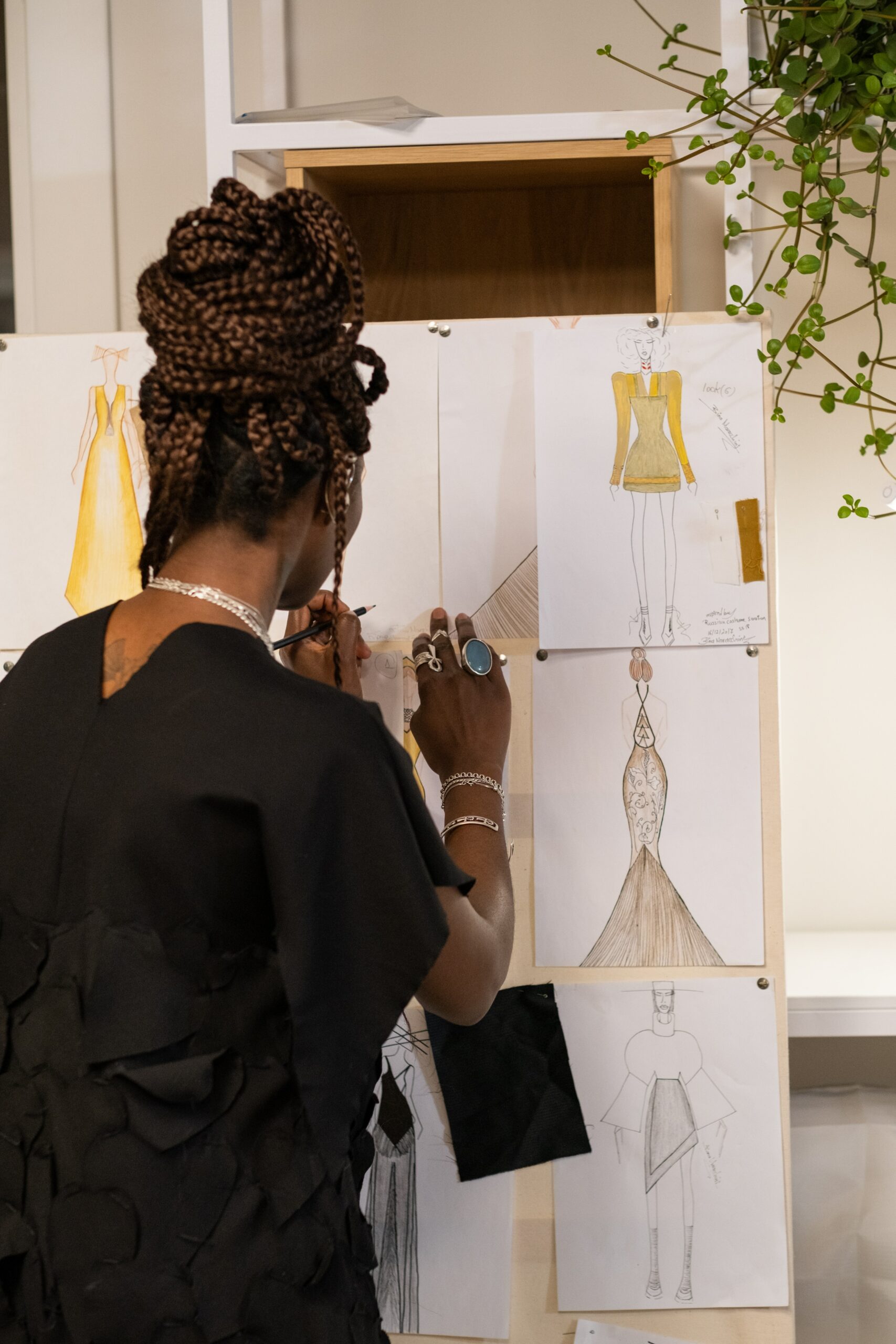Features
Nympha Nzeribe: How to Thrive as an Emerging Fashion Designer

The subject of the current challenges faced by individuals in various sectors of the economy often goes unnoticed. These challenges impact their professional output as they navigate their daily tasks. Take, for instance, the fashion industry, where concerns have been raised regarding the declining productivity of average fashion designers. In a dynamic economy like Nigeria’s, the fashion industry offers both opportunities and obstacles for these designers.
For those operating within limited means in this field, adaptability, ingenuity, and a profound grasp of local realities are essential. This raises the question: How can a lower-class fashion designer effectively manoeuvre the harsh economic landscape and still achieve success? This inquiry is intricate, particularly considering the current trend of reduced acknowledgement for those on the less privileged end of the spectrum, further emphasising that their ability to remain relevant to a wider audience primarily depends on their creative abilities.
Amidst the challenges that cast a shadow over the industry, especially affecting aspiring fashion designers from less privileged backgrounds, it’s important to acknowledge the positive impact of fashion design in Nigeria and across Africa. This impact is reflected in its contribution to economic growth, evident in the remarkable entrepreneurial spirit driving the creation of designs that set both local and international trends originating from this region.
The fashion design industry, particularly in creating well-thought-out designs, possesses a distinctive quality. This uniqueness stems from the fact that, even in the face of a global economic slowdown, the demand for clothing remains constant. Moreover, during periods of reduced demand in a specific clothing market, resourceful entrepreneurs can seize opportunities in untapped foreign and emerging markets, thereby bolstering sales. However, a major challenge comes to the forefront in this scenario, as a multitude of designers enter the field daily due to a lack of alternative pursuits. This situation initiates a competitive environment where only the most adaptable and innovative can thrive.
What exactly are the issues with being a low-class fashion designer?
A lot of issues are prevalent when it comes to dealing with the harsh realities of the economy as a low-class fashion designer. In these challenging economic circumstances, consumers frequently curtail their discretionary expenses, including fashion outlays. Consequently, consumers’ disposable income decreases, rendering them more sensitive to prices. Average fashion designers then begin to encounter difficulties in selling higher-priced items, compelling them to contemplate more budget-friendly alternatives or implement discounts.
The escalation of raw material costs, manufacturing expenses, and logistical charges due to inflation and currency devaluation presents an additional hurdle. Maintaining competitive pricing while grappling with heightened production costs can prove demanding for fashion designers.
Adding to these is the scarcity of access to capital. Acquiring financing or loans for fashion enterprises can be an uphill battle, particularly for less privileged fashion designers lacking the necessary collateral or advocates to procure funds on their behalf. This predicament can impede designers from investing in novel collections, marketing endeavours, and expansion initiatives.
The proliferation of designers offering economical alternatives to cater to price-conscious consumers presents another quandary. This influx amplifies competition and saturates the market.
More so, recurrent power blackouts and fluctuations disrupt production workflows, hinder quality control, and increase expenses as designers must resort to backup power solutions like generators. The limited operational hours, compromised technological and communication capabilities, and suboptimal equipment utilisation further debilitate productivity. The damage inflicted on equipment and materials by power-related issues also contributes to elevated maintenance and repair outlays, which can be particularly burdensome for an average fashion designer.
How can low-class fashion designers thrive in a harsh economy?
From struggling with the evident challenges to the ever-evolving landscape of fashion trends and controversies, the issues within the fashion industry are sufficient to demoralise even the most seasoned veterans of the field. Whether you’re an esteemed haute couture designer or an average one, it’s undeniable that the fashion sector presents a daunting path to traverse. Yet, grasping these challenges marks the primary stride toward not just surviving but flourishing within the unforgiving economy.
However, one can hop on solutions to mitigate the impacts of being a typical fashion designer in a harsh economy.
Innovative designs with stories
This brings to mind Joel Spolsky‘s famous words, “Design adds value faster than it adds costs.” In a competitive market, standing out is crucial. Low-class designers can captivate their audience by crafting designs that tell a story. This narrative could be rooted in their indigenous history, culture, or societal issues. Creating a connection between the design and its inspiration can make the clothing more meaningful, and appealing to consumers looking for unique pieces with depth. In the pursuit of these groundbreaking designs, opportunities abound to forge partnerships with local boutiques, modest retailers, or even fellow designers for joint ventures. Such partnerships can serve as conduits to diverse customer segments, while concurrently amplifying the resonance of the narrative at the core of your brand.
Resourcefulness and sustainability
The harsh economic realities necessitate resourcefulness. Low-class designers can find ways to repurpose and upcycle materials, minimising waste and production costs. This approach not only aligns with global sustainability standards but also demonstrates a commitment to ethical fashion. These strategies have the potential to strike a chord with eco-minded customers and enhance the brand’s attractiveness, ultimately resulting in a broader consumer audience.
Social media and online presence
The impact of social media on businesses in today’s challenging economy cannot be overemphasised. Digital platforms provide an economical avenue for low-class designers to exhibit their creations and reach a wider spectrum of people. Regardless of your perspective, one thing is certain, Steve Ballmer said, “Accessible design is good design”. By leveraging platforms such as Instagram, Facebook, and Twitter, designers can share their designs, engage with customers, and receive valuable feedback. Consistent delivery of top-notch content holds the potential to build a loyal online following and attract potential customers. In the spirit of enhancing visibility, sharing your skills by offering DIY workshops or sewing classes to supplement income becomes expedient.
Affordable pricing strategies
The economic hurdles encountered by a significant number of people have made prioritising affordability paramount. Designers catering to the lower economic strata can adopt effective pricing tactics that address a wide range of customers. By presenting an array of products at varying price tiers, the brand guarantees inclusiveness, thereby extending its reach to different segments of income earners.
Pop-up shops and market stalls
Low-class designers might face constraints in securing physical retail spaces, but they can turn to pop-up shops and market stalls as a feasible substitute. These temporary setups offer designers the opportunity to present their collections directly to prospective customers and gain real-time feedback. Additionally, market stalls and exhibitions tap into Africa’s dynamic street market culture, where fashion frequently takes centre stage.
Across all these realities, the undeniable truth remains that both high-class and low-class designers navigate the complexities of challenging economic circumstances. But everyone starts from the low-class before they become high-class.
For budget-conscious, low-class fashion designers to triumph in a demanding economic landscape, a fusion of creativity, practicality, and a profound understanding of community preferences is imperative. As Maya Angelou aptly put it, “You can’t use up creativity. The more you use, the more you have.” Thus, consistently integrating inventive design concepts, environmentally conscious approaches, and online engagement—while ensuring affordability and establishing a local market presence—can empower low-class designers to carve out a distinct niche in the field of fashion.
More so, active participation in local fashion gatherings, trade expos, and networking occasions is advised. These platforms facilitate connections with fellow designers, potential clientele, and industry experts which can provide opportunities. While the path may not be easy, with persistence and a creative strategy, it’s feasible to thrive and contribute significantly to the fashion landscape, even within a challenging economic context.
***




















